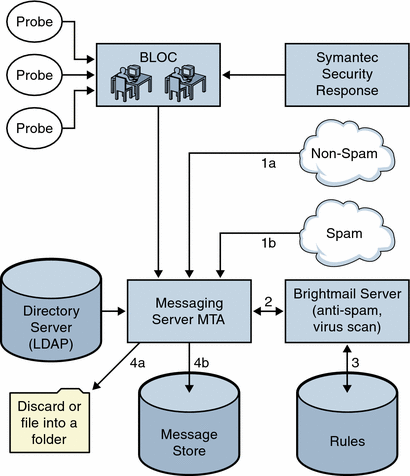How Brightmail Works
The Brightmail server is deployed at a customer site. Brightmail has email probes set around the Internet for detection of new spam. Brightmail technicians create custom rules to block this spam in realtime. These rules are downloaded to Brightmail servers, also in realtime. The Brightmail database is updated and Brightmail server runs this database filter against the email for the specified users or domains.
Brightmail Architecture
Figure 14–1 depicts the Brightmail architecture.
Figure 14–1 Brightmail and Messaging Server Architecture

When the Brightmail Logistics and Operations Center (BLOC) receives spam from email probes, operators immediately create appropriate spam filtering rules, which are downloaded to Brightmail customer machines. Similarly, the Symantec Security Response realtime virus rules are also sent from Brightmail. These rules are used by customer’s Brightmail servers to catch spam and viruses.
The MTA uses the Brightmail SDK to communicate with the Brightmail Server. The MTA dispatches messages based on the response from Brightmail. After the mail (1a) or (1b) is received by the MTA, the MTA sends the message to the Brightmail server (2). The Brightmail server uses its rules and data to determine if the message is a spam or virus (3), and returns a verdict to the MTA. Based on the verdict, the MTA either (4a) discards the message or files the message into a folder, or (4b) delivers it normally to the destination.
Since the Brightmail SDK is third party software, we do not include it in our installation kit. The Brightmail SDK and server software must be obtained from Brightmail Inc. The MTA has configuration settings to tell it whether and where to load the Brightmail SDK to enable Brightmail integration.
Once the SDK is loaded, Brightmail message processing is determined by several factors and levels of granularity (the term used by Brightmail to specify active processing is optin). This is specified by the following criteria:
-
Whether the source or destination channel is enabled for Brightmail (imta.cnf)
-
Whether there is a channel default for the services opted in (imta.cnf)
-
Whether there is a per domain optin (LDAP)
-
Whether there is per-user optin (LDAP)
For any particular message recipient, the optins and defaults above are combined, which means, if the channel default is already specified for both spam and virus, then there is no reason to bother with per-user optin. That is, if the system administrator decides to do spam and virus filtering for everyone, then there is no reason to expose to the user the ability to optin for spam or virus. There is no way to opt out of processing, that is, you can not say you do not want the service if a user is already optin via a system or domain optin. This also means that if you are optin for a service, and you have forwarded your mail to another address, that address would get the mail after the filtering has been performed on your behalf.
There are only two services offered, virus or spam detection. Brightmail also provides “content-filtering” service, but this functionality is provided using Sieve, so there is no added value to have Brightmail do the Sieve filtering.
When a message is determined to contain a virus, the Brightmail server can be configured to clean the virus and resubmit the cleaned message back to the MTA. (Due to some undesirable side effects caused by loss of information about the original message in a resubmitted cleaned message, we recommend you do not configure Brightmail to resubmit the cleaned message back to the MTA.) When the message is spam, the verdict back from the Brightmail along with the configuration in Brightmail allows the MTA to determine what happens to the message. The message can be discarded, filed into a folder, tagged as spam or virus on the subject line, passed to a Sieve rule, delivered normally in the INBOX, and so on.
The Brightmail servers can be located on the same system as the MTA, or it can be on a separate system. In fact, you can have a farm of Brightmail servers serving one or more MTAs. The Brightmail SDK uses the Brightmail configuration file to determine which Brightmail servers to use.
- © 2010, Oracle Corporation and/or its affiliates
